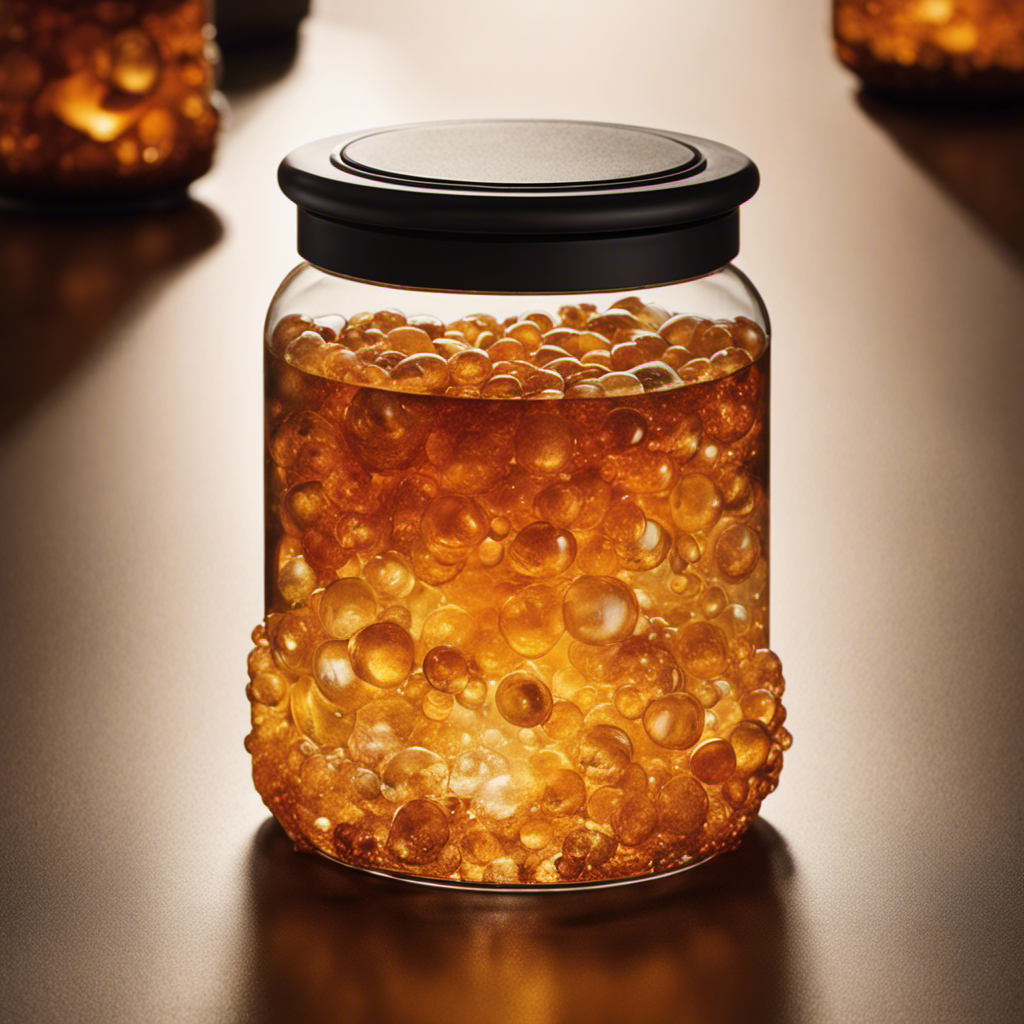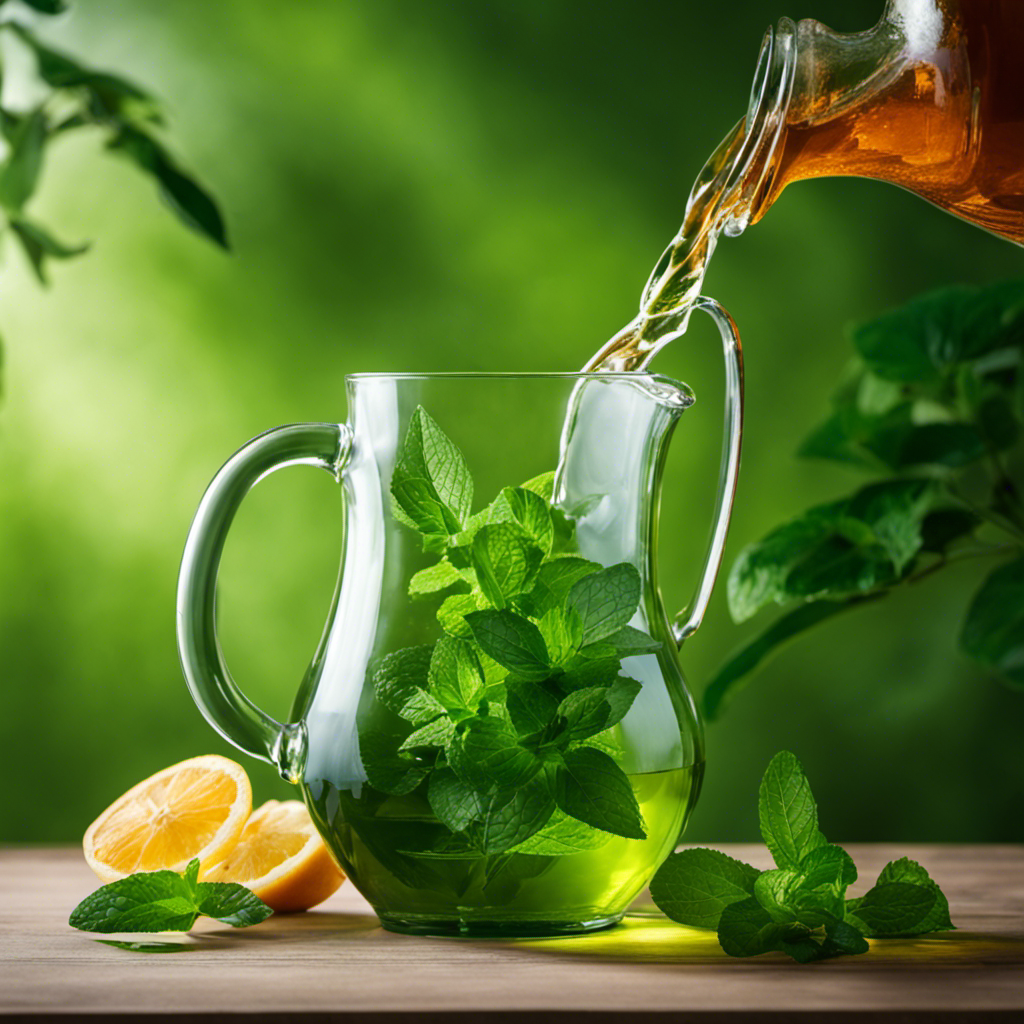Turmeric Tea
How to Make Fermented Kombucha Tea

I have to confess, I was doubtful about brewing my own fermented kombucha tea. However, after giving it a try, I became addicted. There’s just something about the tangy, bubbly goodness that is unbeatable.
And the best part? It’s actually pretty easy to make at home. In this article, I’m gonna walk you through the simple steps to brewing, fermenting, and bottling your own homemade kombucha.
Get ready to become a master kombucha brewer in no time.
Key Takeaways
- Choosing the right ingredients is crucial for producing high-quality kombucha.
- Different brewing methods offer versatility and options for personal preference.
- Fermentation process takes about 7 to 10 days but can vary.
- Store kombucha in the refrigerator to maintain flavor and fizziness.
Choosing the Right Ingredients
When making fermented kombucha tea, it’s important to choose the right ingredients. Finding the best tea leaves is crucial for producing a high-quality brew. Look for organic, loose-leaf black or green tea, as they contain the necessary compounds for fermentation. Avoid using tea bags, as they may have added chemicals or oils that can hinder the fermentation process.
Additionally, understanding the role of sugar is essential. Sugar acts as the fuel for the fermentation process, providing food for the SCOBY (symbiotic culture of bacteria and yeast). It’s recommended to use organic cane sugar or white granulated sugar, as they are easily digestible for the SCOBY.
Remember to use the proper ratio of tea leaves to sugar to ensure a successful and delicious batch of kombucha.
Brewing the Kombucha Tea
To brew it, you’ll need to let the mixture sit for 7-10 days to allow fermentation to occur. During this time, the SCOBY (Symbiotic Culture Of Bacteria and Yeast) will consume the sugar and transform it into beneficial acids and probiotics.
Here are some different brewing methods to try:
- Continuous Brewing: This method involves removing a portion of the fermented tea and adding fresh sweet tea in a continuous cycle.
- Batch Brewing: In this method, you brew a new batch of kombucha each time, starting from scratch.
- Second Fermentation: After the initial fermentation, you can add flavors like fruit or ginger and let it sit for a few more days to develop carbonation.
Troubleshooting common issues:
- Mold: If you see mold growing on your SCOBY or the surface of the tea, discard everything and start over with a fresh SCOBY.
- Vinegar-like taste: This could be a sign of over-fermentation. Reduce the fermentation time in your next batch.
- No carbonation: Make sure you have airtight bottles for the second fermentation and add a small amount of sugar to promote carbonation.
- Too sweet: Ferment for a longer period of time in the next batch.
Fermenting the Tea
During the fermentation process, you’ll notice bubbles forming in the mixture as the SCOBY consumes the sugar and transforms it into beneficial acids and probiotics. This transformation is what gives kombucha its unique tangy flavor and health benefits. The fermentation process typically takes about 7 to 10 days, but can vary depending on factors like temperature and the strength of the SCOBY. It’s important to monitor the fermentation process by tasting the kombucha daily to ensure it reaches the desired level of acidity. Once the fermentation is complete, you can strain the kombucha and transfer it into bottles for a second round of fermentation, which creates carbonation. It’s important to note that during the fermentation process, the alcohol content may increase slightly, but it is usually very low and safe for consumption. Overall, the fermentation process is what makes kombucha a delicious and nutritious beverage packed with probiotics and other health benefits.
| Fermentation Tips | Health Benefits | Flavor Combinations |
|---|---|---|
| Use a clean jar and cover it with a cloth or coffee filter to allow airflow | Supports gut health and digestion | Ginger + Lemon |
| Keep the jar in a warm, dark place away from direct sunlight | Boosts immune system | Raspberry + Mint |
| Avoid using metal utensils or containers, as they can interfere with the fermentation process | Detoxifies the body | Blueberry + Lavender |
| Taste the kombucha daily to gauge the level of acidity | Rich in antioxidants | Peach + Basil |
| Experiment with different brewing times to find your preferred flavor profile | May help to reduce inflammation | Strawberry + Rose |
Bottling and Carbonating the Kombucha
After the fermentation process, you can strain the kombucha and transfer it into bottles for a second round of fermentation, which creates carbonation. This step is crucial for achieving that fizzy, refreshing taste that we all love in kombucha.
Here are some carbonation techniques and flavoring options to consider:
-
Carbonation Techniques:
-
Use airtight bottles to trap the carbon dioxide produced during fermentation.
-
Let the bottles sit at room temperature for a few days to allow carbonation to occur.
-
Burp the bottles daily to release excess pressure and prevent explosions.
-
Experiment with different fermentation times to achieve your desired level of carbonation.
-
Flavoring Options:
-
Add fresh fruit, such as berries or sliced citrus, to infuse flavors into the kombucha.
-
Try adding herbs or spices like ginger, mint, or lavender for a unique twist.
-
Consider using flavored tea or fruit juices for added depth of flavor.
-
Don’t be afraid to get creative and try different combinations to find your favorite.
Now that your kombucha is bottled and carbonating, let’s move on to the next step: storing and enjoying your homemade creation.
Storing and Enjoying Your Homemade Kombucha
Now that you’ve bottled and carbonated your homemade kombucha, it’s time to store it properly and enjoy the fruits of your labor.
Storing your kombucha correctly is crucial for maintaining its flavor and fizziness. The best method is to keep it in the refrigerator, as this slows down the fermentation process and helps retain its taste. You can store your kombucha in glass bottles with airtight lids to prevent any contamination and maintain its carbonation.
It’s important to note that the longer you store it, the more acidic it becomes, so it’s best to consume it within a few weeks for optimal taste.
Now, let’s talk about flavor variations. Once you’ve mastered the basic kombucha recipe, you can experiment with adding different fruits, herbs, or spices during the second fermentation process. This allows you to create unique and delicious flavor combinations that suit your preferences.
Enjoy exploring the endless possibilities of homemade kombucha!
Conclusion
In conclusion, making fermented kombucha tea is like embarking on a journey of transformation. With the right ingredients and brewing techniques, you can witness the magical alchemy of tea turning into a tangy and effervescent elixir.
Just like the tea leaves, we too can undergo a fermentation process, growing and evolving into something greater than before.
So, take a leap of faith, embrace the art of kombucha-making, and savor the rewards of a homemade tonic that nourishes both body and soul.
Cheers to the power of fermentation!
In the vast and diverse world of coffee, coffee alternatives, and tea, Olivia has found her calling. As an author and a dedicated coffee and tea aficionado, her work for Cappuccino Oracle reflects her profound love and understanding of the intricate complexities found within these beverages. Olivia’s passion for the subject serves as both a catalyst for her creativity and a connection point with her audience.
Olivia’s appreciation for coffee, coffee alternatives, and tea blossomed at an early age. She discovered that these beverages invigorated her senses and stimulated her creative spirit. From the nuanced flavors of single-origin roasts to the captivating narratives intertwined with coffee, coffee alternatives, and tea trade and culture, Olivia found an unlimited source of inspiration in her daily cup.
Her love for these beverages and her talent for storytelling eventually converged at Cappuccino Oracle. As an author, Olivia’s mission is to illuminate the intricate tapestry that makes up the world of coffee, coffee alternatives, and tea. Her articles span a diverse range of topics, encompassing everything from the unique flavors of different brews to the sociocultural history intertwined with their cultivation and consumption.
Turmeric Tea
How to Make Kombucha Tea Fizzy
As a fan of kombucha, I’ve always been intrigued by the pleasant fizz that tickles my taste buds with each sip.
In this guide, I’ll share my secrets to making kombucha tea fizzier than ever before. Get ready to unlock the science behind this effervescent delight and discover the key ingredients that will elevate your brew.
Follow my step-by-step instructions and learn the carbonation techniques that will make your kombucha bubble with excitement.
Say goodbye to flat brews and hello to the perfect fizzy kombucha tea!
Key Takeaways
- Carbonation in kombucha is a result of yeast converting sugar into alcohol and carbon dioxide gas during fermentation.
- Second fermentation in a sealed container and longer fermentation time can increase the fizziness of kombucha.
- Using fresh and ripe fruit juices or purees can add depth and complexity to the kombucha and contribute to carbonation.
- Natural carbonation techniques involve bottling with added sugar and fermenting, while forced carbonation using a carbonation system allows for precise control and quicker results for those who prefer higher levels of fizz.
The Science Behind Fizziness in Kombucha Tea
To understand why your kombucha tea becomes fizzy, you need to know the science behind it.
The carbonation process in kombucha is mainly due to the role of yeast during fermentation. When making kombucha, a SCOBY (Symbiotic Culture of Bacteria and Yeast) is added to sweetened tea. The yeast in the SCOBY consumes the sugar and converts it into alcohol and carbon dioxide gas through a process called fermentation.
The carbon dioxide gas produced gets trapped in the liquid, creating the fizziness. As the fermentation continues, the carbonation level increases. This is why it’s important to let your kombucha undergo a second fermentation in a sealed container to build up carbonation.
The longer you let it ferment, the fizzier your kombucha will be.
Choosing the Right Ingredients for Fizzy Kombucha Tea
When choosing the right ingredients, you’ll want to ensure that you use fresh fruit juices or purees to achieve a fizzy kombucha tea. These ingredients are crucial for the fermentation process, which is responsible for creating carbonation in the tea. Here are a few key points to consider:
-
Quality of Fruit: Choose fruits that are ripe and flavorful, as they will add depth and complexity to your kombucha. Avoid using fruits that are overly sweet or acidic, as they can affect the fermentation process.
-
Freshness: It is essential to use fresh fruit juices or purees to ensure the best results. Fresh ingredients contain natural sugars and enzymes that contribute to the fermentation process and carbonation.
-
Variety: Experiment with different fruits to find your desired flavor profile. Some popular choices include berries, citrus fruits, and tropical fruits. Each fruit brings its unique characteristics to the kombucha, resulting in a diverse range of flavors.
Step-by-Step Guide to Fermenting Kombucha Tea for Maximum Fizz
Follow these steps to ensure you achieve maximum fizz when fermenting your kombucha tea.
The fermentation process is crucial in creating that desired effervescence.
- First, prepare a sweetened tea base and let it cool.
- Then, add a SCOBY (symbiotic culture of bacteria and yeast) to initiate fermentation.
- Cover the container with a breathable cloth to allow air circulation.
- Let the tea ferment for 7-10 days, depending on your flavor preferences.
- As the fermentation progresses, bubbles will form, indicating the carbonation is building up.
After the desired fermentation time, it’s time to bottle your kombucha.
- Add some fruit juice or other flavorings to create delicious flavor variations.
- Seal the bottles tightly and allow them to sit at room temperature for a few days to build carbonation.
Carbonation Techniques for Fizzy Kombucha Tea
Achieving maximum fizz in your kombucha is all about using the right carbonation techniques. Carbonation gives kombucha its signature effervescence, making it a refreshing and enjoyable beverage. Here are some methods to help you achieve that perfect fizz:
-
Natural Carbonation: This method involves bottling the kombucha with added sugar and allowing it to ferment further, creating carbonation naturally. This process takes a few days to a week, but the result is a well-carbonated kombucha with a smooth and consistent fizz.
-
Forced Carbonation: Utilizing a carbonation system like a soda siphon or kegging system, forced carbonation allows you to control the level of carbonation precisely. This method is quicker than natural carbonation and is ideal for those who prefer a higher level of fizz.
-
Flavor Variations: Experimenting with different flavors during the carbonation process can add a new dimension to your kombucha. Adding fruits, herbs, or spices to the bottle before carbonation can infuse unique flavors into your fizzy kombucha.
Troubleshooting Tips for Achieving the Perfect Fizz in Kombucha Tea
To troubleshoot and achieve the perfect fizz in your kombucha, you can try adjusting the fermentation time or temperature.
Carbonation is a key aspect of kombucha, but sometimes it can be challenging to get it just right. One common problem is a lack of fizz, which can leave your kombucha tasting flat and unappealing.
To troubleshoot this issue, you can try increasing the fermentation time. This allows the yeast to consume more sugar and produce more carbon dioxide, resulting in a fizzier brew. Another option is to adjust the fermentation temperature. Yeast activity is influenced by temperature, so finding the optimal range can help promote carbonation.
Experimenting with these troubleshooting techniques can help you achieve the perfect fizz in your homemade kombucha.
Conclusion
In conclusion, achieving the perfect fizz in kombucha tea is not only possible but also quite fascinating. By understanding the science behind the fizzy nature of kombucha, choosing the right ingredients, and following a step-by-step fermentation process, you can create a bubbly and refreshing beverage.
Experimenting with carbonation techniques such as secondary fermentation or adding fruit juices can further enhance the fizziness. Imagine enjoying a glass of sparkling kombucha tea on a hot summer day, its effervescence dancing on your taste buds, invigorating and satisfying.
The possibilities are endless!
In the vast and diverse world of coffee, coffee alternatives, and tea, Olivia has found her calling. As an author and a dedicated coffee and tea aficionado, her work for Cappuccino Oracle reflects her profound love and understanding of the intricate complexities found within these beverages. Olivia’s passion for the subject serves as both a catalyst for her creativity and a connection point with her audience.
Olivia’s appreciation for coffee, coffee alternatives, and tea blossomed at an early age. She discovered that these beverages invigorated her senses and stimulated her creative spirit. From the nuanced flavors of single-origin roasts to the captivating narratives intertwined with coffee, coffee alternatives, and tea trade and culture, Olivia found an unlimited source of inspiration in her daily cup.
Her love for these beverages and her talent for storytelling eventually converged at Cappuccino Oracle. As an author, Olivia’s mission is to illuminate the intricate tapestry that makes up the world of coffee, coffee alternatives, and tea. Her articles span a diverse range of topics, encompassing everything from the unique flavors of different brews to the sociocultural history intertwined with their cultivation and consumption.
Turmeric Tea
How to Make Kombucha Starter Tea
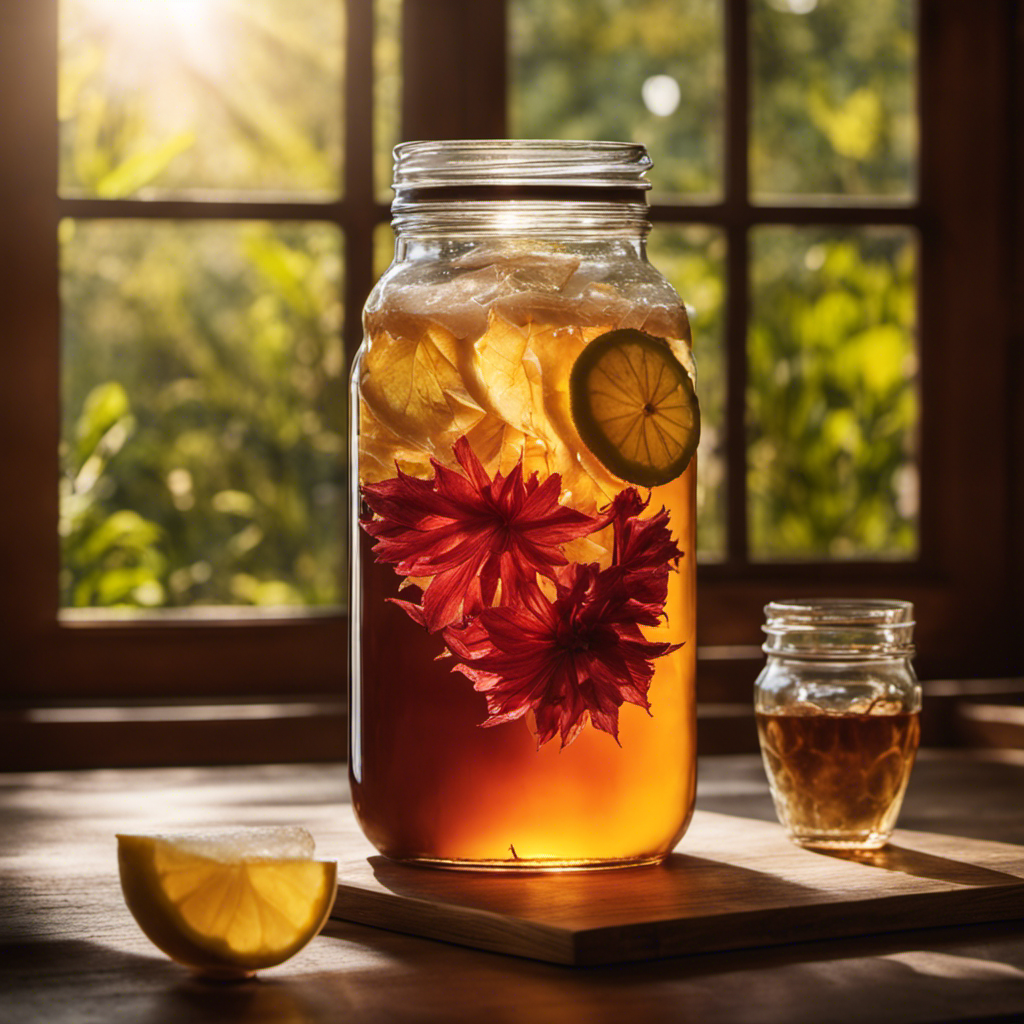
Have you ever heard that Kombucha has been enjoyed for generations and is thought to provide a variety of health advantages?
Well, I’m here to show you how to make your own Kombucha Starter Tea, so you can enjoy its probiotic goodness right at home.
In this article, I’ll guide you through the process step-by-step, from choosing the right ingredients to fermenting and storing your tea.
Get ready to embark on a journey of homemade Kombucha greatness!
Key Takeaways
- Kombucha starter tea offers benefits such as improved digestion, increased energy levels, probiotic properties, and a wide range of flavor variations.
- Choosing the right ingredients for kombucha starter tea involves using organic sugar, filtered water, and black, green, or white tea leaves without artificial flavors or additives.
- The step-by-step guide to brewing kombucha starter tea includes preparing the ingredients and equipment, brewing the tea, combining the ingredients, fermenting the tea, and troubleshooting common issues.
- Some fermentation tips for kombucha starter tea include keeping the jar in a warm and dark area, adjusting fermentation time, adding fruit juice or pureed fruit for a fruity twist, experimenting with herbs and spices, and troubleshooting common issues.
Benefits of Kombucha Starter Tea
There are numerous benefits to drinking kombucha starter tea. One of the main advantages is improved digestion and increased energy levels. Kombucha is a fermented tea that contains probiotic properties. These probiotics are beneficial bacteria that aid in promoting a healthy gut. By introducing these good bacteria into your digestive system, kombucha starter tea can help improve digestion and overall gut health.
Additionally, kombucha starter tea is known for its energizing effects. This is due to the presence of B vitamins and iron, which are essential nutrients for maintaining energy levels. So, not only does kombucha starter tea offer health benefits, but it also provides a delicious and refreshing beverage option.
Another advantage of kombucha starter tea is its wide range of flavor variations. From fruity to tangy, there is a flavor for everyone’s taste preferences. This makes it a versatile drink that can be enjoyed by anyone looking for a tasty and healthy beverage option.
Choosing the Right Ingredients for Kombucha Starter Tea
When choosing the right ingredients for your kombucha starter tea, it’s important to use organic sugar and filtered water. Organic sugar ensures that your kombucha is free from harmful pesticides and chemicals, while filtered water removes impurities that may affect the fermentation process.
Here are some brewing process tips to consider:
- Use organic tea leaves: Opt for black, green, or white tea leaves that are free from artificial flavors or additives.
- Avoid flavored teas: Flavored teas may contain oils or additives that can harm the SCOBY culture.
- Choose a healthy SCOBY: Look for a firm and smooth SCOBY with no signs of mold or discoloration.
- Maintain the right temperature: Keep your brewing vessel in a warm area, ideally between 75-85°F, to promote fermentation.
Step-by-Step Guide to Brewing Kombucha Starter Tea
To brew your own kombucha, start by gathering the necessary ingredients and equipment. Here’s a step-by-step guide to help you make your own delicious kombucha starter tea.
Prepare the ingredients and equipment:
- 1 gallon glass jar
- 8-10 tea bags or 2 tablespoons loose tea
- 1 cup sugar
- 1 SCOBY (Symbiotic Culture of Bacteria and Yeast)
- 2 cups starter liquid (previously made kombucha)
Brew the tea:
- Bring 4 cups of water to a boil and steep the tea for 5-7 minutes.
- Stir in the sugar until dissolved, then let it cool to room temperature.
Combine the ingredients:
- Add the cooled tea to the glass jar, then pour in the starter liquid.
- Gently place the SCOBY on top of the liquid.
Ferment the tea:
- Cover the jar with a breathable cloth and secure it with a rubber band.
- Place the jar in a warm, dark area and let it ferment for 7-14 days.
Troubleshooting common issues:
- If your kombucha tastes too sweet, let it ferment for a few more days.
- If it tastes too sour or vinegary, ferment it for a shorter time.
- If you see mold on the surface, discard the entire batch and start over.
Fermentation Tips for Kombucha Starter Tea
For better fermentation, keep the glass jar containing your kombucha starter tea in a warm and dark area. This will create the optimal environment for the fermentation process to take place.
Here are some tips to troubleshoot common issues in fermenting kombucha starter tea and explore different flavor variations:
-
Troubleshooting common issues:
-
If your kombucha tastes too sweet, it may not have fermented long enough. Let it ferment for a few more days to achieve a more tart flavor.
-
If your kombucha tastes too sour or vinegary, it may have fermented for too long. Shorten the fermentation period to achieve a milder taste.
-
Exploring different flavor variations:
-
Add fruit juice or pureed fruit during the second fermentation for a fruity twist.
-
Experiment with herbs and spices like ginger, lavender, or mint to add unique flavors to your kombucha.
Storage and Maintenance of Kombucha Starter Tea
To properly store and maintain your kombucha starter tea, ensure that the glass jar is tightly sealed to prevent any contamination or air exposure.
Storing your starter tea correctly is essential for maintaining its quality and ensuring the success of your kombucha brewing. Here are some storage tips to help you keep your starter tea fresh and healthy.
First, make sure to store the jar in a cool and dark place, away from direct sunlight. Sunlight can degrade the tea and affect the fermentation process.
Secondly, avoid storing the jar near strong odors as the starter tea is known to absorb smells easily.
Lastly, regularly check the seal of the jar to make sure it is still airtight. Troubleshooting common issues such as mold or off-flavors can often be traced back to improper storage.
Conclusion
In conclusion, making kombucha starter tea is like planting a seed of health and vitality. As the tea ferments and transforms, it symbolizes the potential for growth and transformation within ourselves.
Just as the tea becomes a nourishing elixir, so too can we cultivate a stronger, more resilient body and mind. By following the simple steps outlined in this guide, we can harness the power of kombucha to support our overall well-being.
So, let’s raise a glass to health and embark on this journey of kombucha brewing!
Arf, an author and an innovative enthusiast of coffee, coffee alternatives, and tea, plays a crucial role as a contributor to the esteemed Cappuccino Oracle platform. Renowned for his curiosity and passion for these captivating beverages, Arf has carved out a unique space for himself in the world of exploration and writing. He realized that coffee, coffee alternatives, and tea are not mere drinks to keep one awake, but universes of flavors and stories waiting to be explored.
Arf’s articles for Cappuccino Oracle blend meticulous research with personal experiences, providing readers with an in-depth understanding of various types of coffee, coffee alternatives, and tea, along with their unique characteristics, cultures, and histories. His honest reviews and engaging narratives guide readers on their own journeys, helping them discover their preferences and find their perfect brew.
Turmeric Tea
Which Tea Is Best for Kombucha
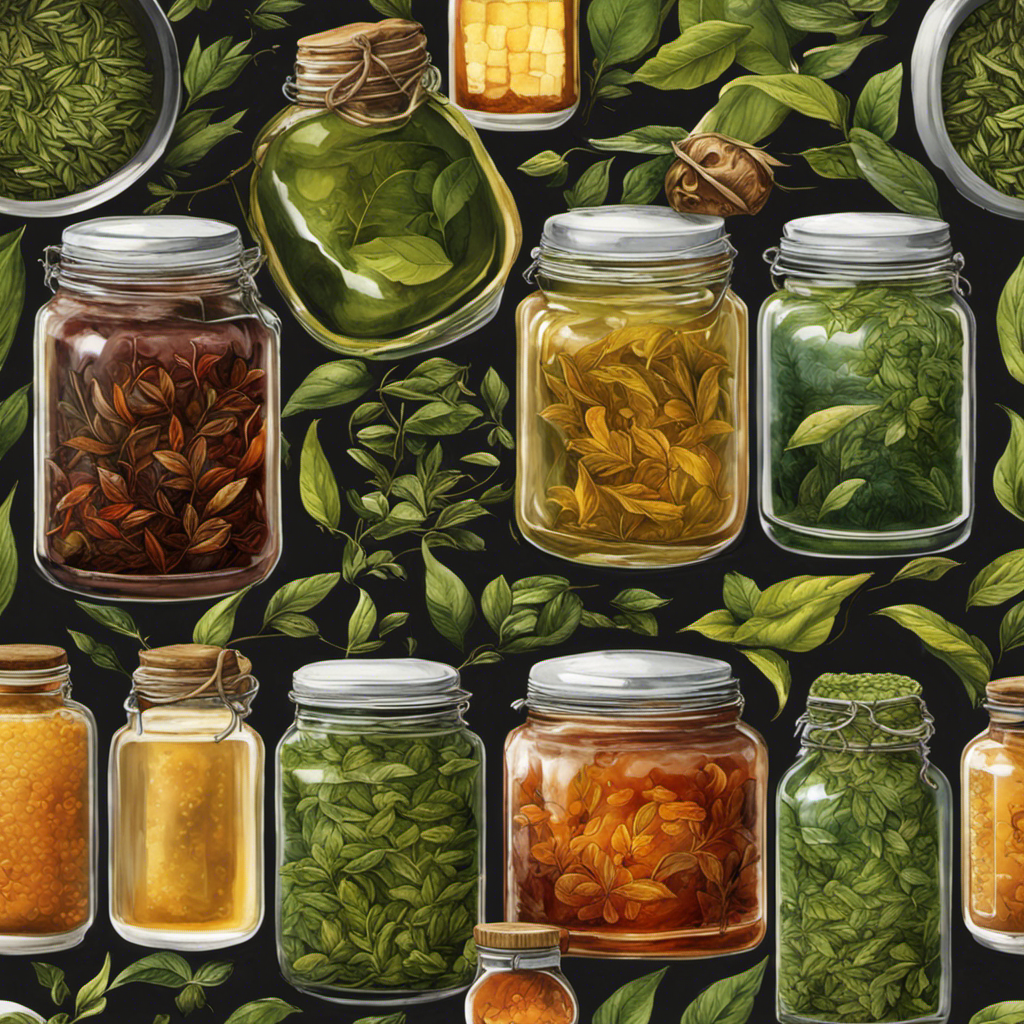
As a passionate fan of kombucha, I have always been captivated by the complex process of crafting this probiotic-packed drink.
One essential element that often goes overlooked is the selection of tea. Just like a painter carefully chooses their colors, the type of tea we use in kombucha can greatly impact its taste and quality.
So, which tea is truly the best for kombucha? Join me as we dive into the world of tea varieties, flavor profiles, and blending techniques to uncover the answer together.
Key Takeaways
- Caffeine from tea is essential for nourishing the SCOBY during kombucha fermentation.
- Traditional teas like black and green are recommended for optimal fermentation results.
- Black tea provides a strong base with a robust flavor, while green tea offers a lighter taste with potential for complex flavors.
- Experimenting with different tea varieties and blends enhances the flavor profiles of kombucha.
The Importance of Tea Selection for Kombucha
When making kombucha, it’s crucial that you choose the right tea. The role of caffeine in kombucha and the impact of herbal teas on kombucha fermentation are important factors to consider.
Caffeine plays a vital role in the fermentation process as it provides nourishment for the SCOBY (symbiotic culture of bacteria and yeast) that transforms the tea into kombucha. The caffeine content in black and green teas is ideal for supporting the SCOBY’s growth and ensuring a healthy fermentation.
On the other hand, herbal teas, such as chamomile or hibiscus, may not contain enough nutrients for the SCOBY to thrive, leading to weak fermentation or a lack of desired flavors. Therefore, it’s best to stick to traditional teas like black or green when brewing kombucha for optimal results.
Factors to Consider When Choosing Tea for Kombucha
One important factor to consider when selecting tea for kombucha is the steeping time. The length of time that the tea leaves are steeped in hot water can significantly impact the flavor and health benefits of the final kombucha brew.
Generally, black, green, and white teas are the most common choices for kombucha. Black tea, with its robust flavor, provides a strong base for fermentation. Green tea, on the other hand, offers a lighter and more delicate taste. White tea, with its subtle floral notes, can add a unique flavor profile to the kombucha.
Factors to consider when choosing tea for kombucha include the quality of the tea leaves, the presence of any additives or flavors, and personal taste preferences. Ultimately, the right tea selection can contribute to a delicious and healthful kombucha brew.
Popular Tea Varieties for Brewing Kombucha
Among the popular tea varieties for brewing kombucha, black tea is known for its robust flavor that provides a strong base for fermentation. However, it is not the only option to consider. Exploring green tea options can also be beneficial, as it brings a lighter and more delicate taste to the final product. Green tea is packed with antioxidants and has been linked to numerous health benefits, including improved brain function and a lower risk of heart disease. To help you make an informed decision, here is a comparison between the two:
| Black Tea | Green Tea |
|---|---|
| Robust flavor | Light and delicate taste |
| Strong base for fermentation | Potential for complex flavors |
| Rich in polyphenols | High in antioxidants |
Both black and green tea have their own unique qualities that can contribute to the fermentation process and the overall taste of your kombucha. So, whether you prefer the boldness of black tea or the subtlety of green tea, the choice ultimately depends on your personal preference and desired flavor profile.
Exploring the Flavor Profiles of Different Teas in Kombucha
If you want to explore the flavor profiles of different teas in your kombucha, you can try experimenting with a variety of options to find the one that suits your taste preferences. When it comes to kombucha, the type and quality of tea you use can greatly impact the fermentation process and the final taste of your brew.
By exploring tea origins in kombucha, you can discover unique flavors and characteristics that each tea brings to the table. Tea quality is also crucial, as higher quality teas tend to produce a more complex and well-rounded flavor profile in kombucha. The type of tea you choose, whether it’s black, green, white, or herbal, will contribute its own distinct notes to the final product.
So, let’s dive into the world of tea and discover how different varieties can elevate your kombucha-making experience.
Now that we understand the importance of tea in kombucha fermentation, let’s move on to some tips for experimenting with tea blends in kombucha-making.
Tips for Experimenting With Tea Blends in Kombucha-Making
Let’s dive into some tips for experimenting with different tea blends when making kombucha. When it comes to creating unique and delicious flavors in your kombucha, the tea blend ratios and flavor combinations you choose play a crucial role. By combining different types of tea, you can create a complex and well-balanced flavor profile.
Here are some tips to get you started:
-
Experiment with different ratios: Try mixing black tea with green tea or herbal tea to create a unique flavor. Start with a 50/50 ratio and adjust to your taste.
-
Blend flavors: Combine fruity teas with floral teas or add a hint of spice to create interesting flavor combinations.
-
Consider caffeine levels: If you prefer a caffeine-free kombucha, try using herbal teas as the base. For a stronger kick, opt for black tea or a blend with higher caffeine content.
-
Don’t be afraid to get creative: Add dried fruits, herbs, or spices to enhance the flavor and aroma of your kombucha.
With these tips, you’ll be able to create a wide variety of delicious kombucha flavors using different tea blends.
Happy brewing!
Conclusion
In conclusion, the choice of tea for kombucha is a crucial factor in determining the flavor and quality of the final brew. By considering factors such as caffeine content, flavor profiles, and fermentation properties, one can select the best tea for their kombucha-making endeavors.
Whether it’s the earthy notes of black tea, the floral aromas of green tea, or the delicate flavors of white tea, there is a tea out there to suit every kombucha enthusiast’s taste.
So, why not embark on a tea-tasting journey and discover the perfect blend for your homemade kombucha?
Noah, the Editor-in-Chief at Cappuccino Oracle, plays a pivotal role in shaping the voice and vision of our renowned platform. With an unwavering passion for coffee, coffee alternatives, and tea, Noah leads Cappuccino Oracle towards new horizons in the realm of coffee journalism.
Beyond his professional responsibilities, Noah serves as a mentor and guiding force for his team. His dedication to journalistic excellence and genuine love for coffee, coffee alternatives, and tea continue to inspire and motivate the Cappuccino Oracle family. In the ever-evolving world of these beverages, Noah’s leadership ensures that our platform remains at the forefront, delivering enlightening and enjoyable content to our readers worldwide.
-
 Americano3 weeks ago
Americano3 weeks agoHow to Make Americano With Moka Pot
-

 Americano1 week ago
Americano1 week agoHow to Make Korean Iced Americano
-
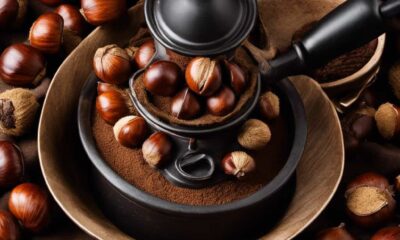
 Americano4 weeks ago
Americano4 weeks agoHow to Make Iced Americano With Instant Coffee
-

 Americano4 weeks ago
Americano4 weeks agoWhat to Add to an Americano at Starbucks
-

 Americano3 weeks ago
Americano3 weeks agoHow to Make Americano With Bialetti
-

 Americano3 weeks ago
Americano3 weeks agoHow to Make Dutch Bros Americano
-

 Americano2 weeks ago
Americano2 weeks agoHow Many Shots of Espresso for 16 Oz Americano
-

 Americano2 days ago
Americano2 days agoHow to Make an Iced Americano With Nespresso








